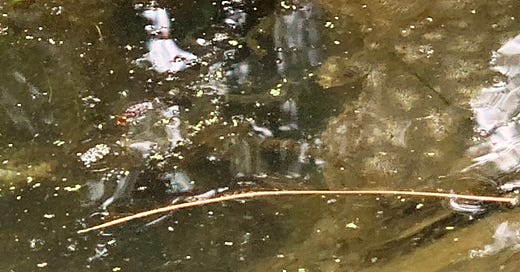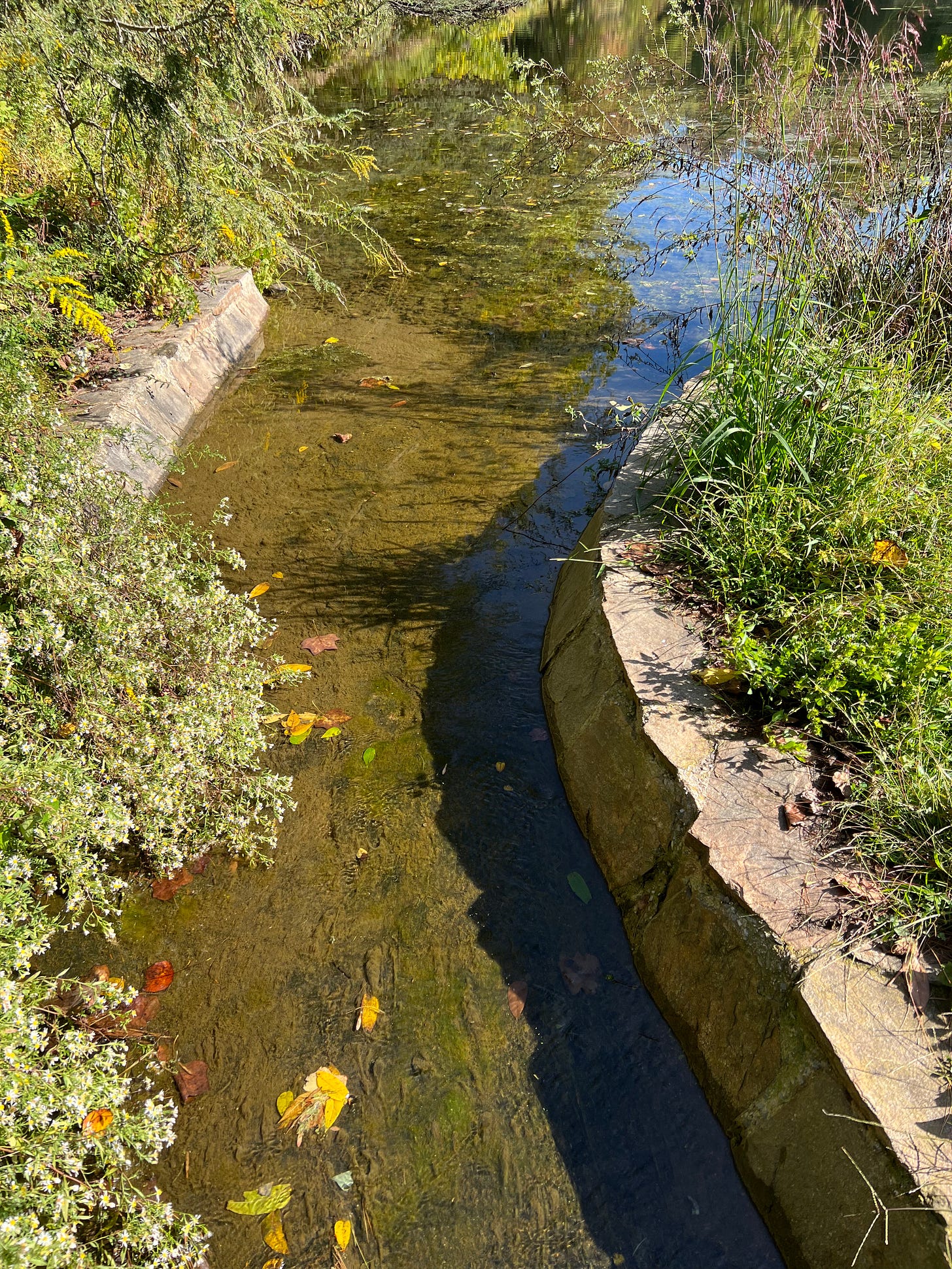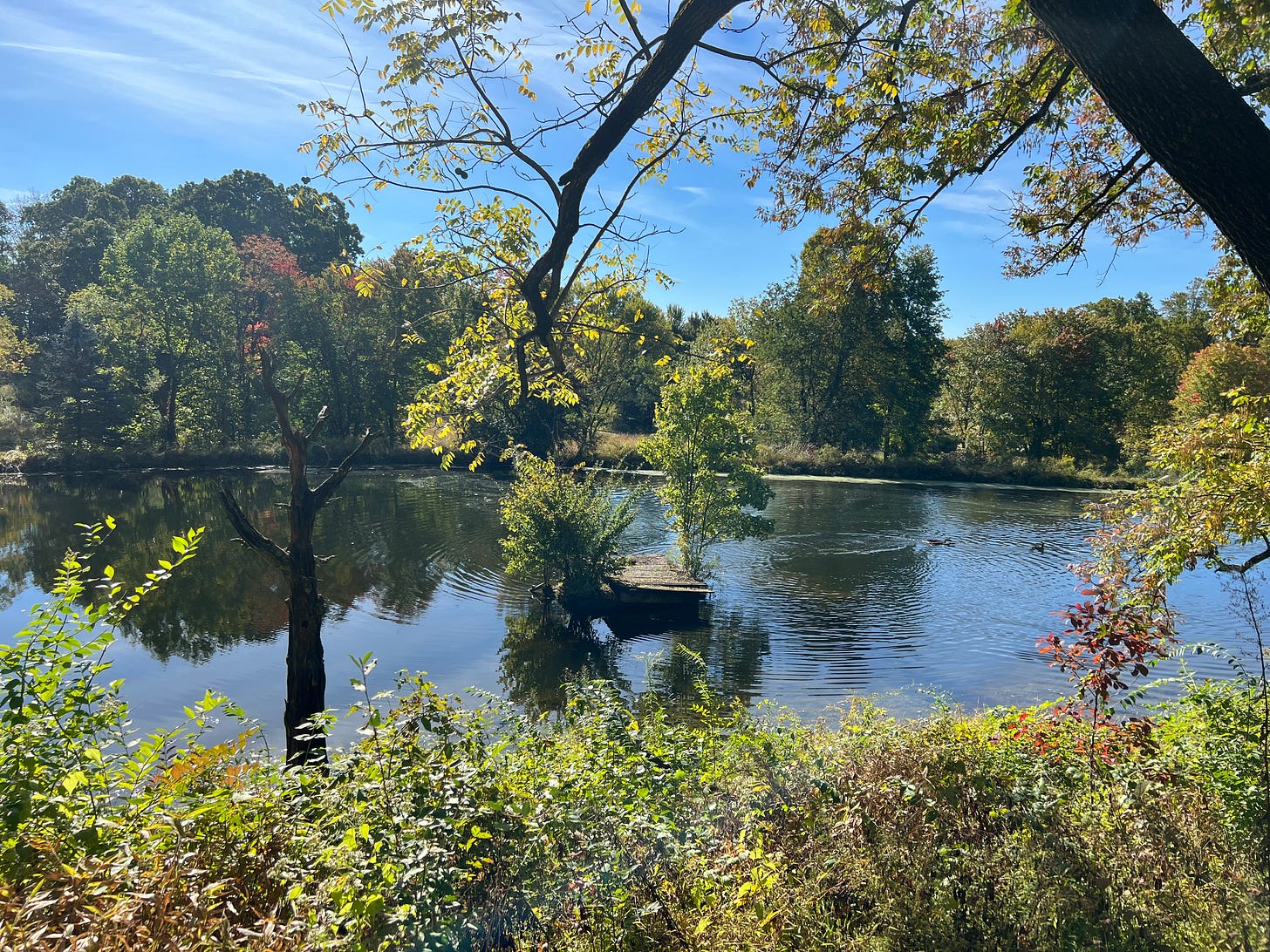Sustainable Pond Strategies
Puddock Hill Journal #26: Seeking Ecological Pond Balance in an Imbalanced World
One of my greatest regrets as a backyard steward was a decision I made in Bedford, NY, in the nineties. In those days, I wasn’t a fully enlightened, ecologically-minded gardener, just a guy trying to improve his yard.
We had bought an old house that overlooked a small pond on our property. A well-established weeping willow hung over the pond on the far side, and an old apple tree grew nearby. The latter was originally engulfed by a multiflora rose and Japanese bittersweet vines so vigorous that they required a chainsaw, loppers and a great deal of tugging over the course of two years to remove. Some fall weekends, I returned to the house bloodied by vengeful multiflora rose thorns.
But, I digress.
The pond, which sat in the midst of a meadow, attracted much wildlife. It had resident green frogs and bullfrogs, received frequent visits from a Belted kingfisher (Ceryle alcyon), who dove for little fish, and we occasionally saw both Great blue herons and Green herons. Other birds flitted about nearby trees. Foxes and deer came to drink. And leeches occasionally attached themselves to our dogs!
All in all a healthy pond but for one small problem. By midsummer, watermeal (Wolffia spp.), a rootless floating plant the size of a pinhead (and the smallest known flowering plant, according to Penn State Extension), covered the pond’s surface. On a still day, people who didn’t know better would look down and mistake our pond for a putting green.
I picked up the phone book (remember phone books?) and called a self-identified pond specialist who recommended copper sulfate, which he was licensed to apply. He proceeded to spray this substance on the pond’s surface from a poke boat that he’d tipped into the water.
I had second thoughts from the moment this guy sprung into action. He seemed one blade short of a full propeller, and the spray application looked pretty random. Sure enough, his very expensive efforts had zero effect on the watermeal. What effect did it have on the environment? Nothing observable to me, but I’m sure not good.
Now that I’m better educated on the subject, I know that copper sulfate is a treatment for algae, and watermeal is NOT algae. Furthermore, the product is toxic to humans and animals in various ways. One manner of toxicity to humans involves dermal exposure, so I can only imagine what it might do to the sensitive skin of an amphibian.
Another thing I’ve learned quite recently is that watermeal is not an invasive plant per se. It is an aggressive native that can damage pond ecosystems, however. According to Penn State Extension, watermeal infestation “can block sunlight, inhibit oxygen exchange, and reduce dissolved oxygen concentrations in the pond water when the plants die and decay.”
So, I wasn’t wrong to fight it, but I went about it in an unsustainable, not to mention futile, way.
Remarkably, the small pond at Puddock Hill has no watermeal, although Eurasian water milfoil covers its bottom. The frogs don’t seem to mind the milfoil (in fact, it likely helps their tadpoles hide), and native wetland plants grow in its shallows, including Arrowhead (Sagittaria latifolia), here in bloom last August:
The big pond, which is deeper and hosts many fish, as well as turtles and frogs, does contain algae, duckweed (another tiny, flowering, floating plant), watermeal, and milfoil. Keeping these things in check presents a constant challenge, but we have so far avoided a fish die-off. Our management practices consist of the following.
Physical Removal
The pond, which is both spring- and surface-fed but man-made, originally had a six-inch vertical overflow pipe and a dirt spillway for additional overflow, both draining into a nearby wetland. Since the overflow pipe’s opening faced straight up, parallel to the pond surface, during times of high water it created fierce suction. One day, I found a mature painted turtle helplessly stuck there. I waded in, rescued him, and capped the pipe within the week.
But I didn’t just cap the pipe because of its danger to wildlife. I came to realize that one way to limit watermeal, floating algae, and duckweed would be to use the spillway as a natural skimmer. The more water going over that spillway, the more watermeal skimmed off. I had the spillway lined with rocks to limit erosion, and stopping up the pipe increased the flow.
Much of the year, this system works well. The biggest challenge is Eurasian water milfoil, which by August has grown high enough in the shallows to snag most of the material on the surface that I wish to skim off. Next year I plan to undertake more aggressive raking of the milfoil in the channel in an effort to limit its impact.
The spillway with increased water flow also carries off other organic flotsam, such as leaves and small sticks. Having some organic matter in the pond is healthy, of course, but too much causes algal blooms. Here’s what the spillway looked like this week, still challenged by milfoil (where pond meets spillway):
Nutrient Management
We discourage geese (and their poop) by letting the edges of the pond grow up, but we still get visitors and an occasional nesting pair, so this strategy is far from foolproof.
In an effort to limit surface runoff of organic nutrients, we have also stopped mowing beside the pond. And, of course, we rarely fertilize the lawn. (Just once, partially, in the past twelve years!) I’d rather have a healthy pond than a perfect lawn.
Biological Control
For years, I have been deploying beneficial bacteria—purchased these days from an outfit called Healthy Ponds (no, I’m not shilling for them)—that consume excess nutrients and break down organic matter. I have never known these products to completely eliminate algae or watermeal, and I certainly haven’t conducted my own controlled experiments, but they do seem to help balance things out.
About five years ago, at the suggestion of someone from the Stroud Water Research Center, which is a great local and national resource, we introduced triploid grass carp (Ctenopharyngodon idella) to consume some portion of emergent vegetation. The carp, which are native to Asia, have been bred to be sterile so they don’t become invasive. Introducing them to a body of water in Pennsylvania requires a permit, which we duly applied for and received. I can’t say I’ve noticed much impact on the vegetation, but it’s fun to spot the surviving carp now and then, as they have grown to three feet long.
In the spirit of backyard stewardship, we continue to tweak things to assist Mother Nature. Next spring, if all goes well, I plan to plant Pickerelweed (Pontederia cordata) in the muckier, shallower end of the pond. These native plants uptake excess nitrogen and phosphorus. The flowers attract butterflies and bees, the seeds feed waterfowl, and I hope the plants, once established, will provide places for frogs and turtles to hide.
I do believe the water in our big pond is clean. The surface runoff mostly originates on our property or in nearby fields, and the springs that feed it are presumably unpolluted. A few years ago, while kayaking, I came across a most remarkable jelly-like formation the size of a soccer ball, attached to a tree root near the surface:
It is a North American colony of native aquatic invertebrates called the Magnificent Bryozoan (Pectinatella magnifica), said to be a sign of good water quality. Also—lo and behold!—the microscopic critters eat algae.
The big pond seen from the high bench, small island in the center that was decked by a prior owner:
Looking upon a lush 40-foot native Bald cypress (Taxodium distichum) from the low bench:
The view southwest from an area we stopped mowing:








